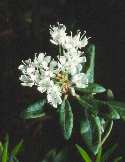Wetland Mixedwood Vegetation
 The vegetation of the Wetlands Mixedwood
Subregion appears quite similar to that of the Central Mixedwood
Subregion, although little is known about much of it. Generally
the landscape in this Subregion contains a greater proportion of wetlands, both
peatlands and willow-sedge complexes on mineral soil, and
more upland Black Spruce forest than the Central Mixedwood. This
perhaps reflects the more rigourous, cooler climate with a lower moisture
deficit. The differences are subtle and need further examination. The vegetation of the Wetlands Mixedwood
Subregion appears quite similar to that of the Central Mixedwood
Subregion, although little is known about much of it. Generally
the landscape in this Subregion contains a greater proportion of wetlands, both
peatlands and willow-sedge complexes on mineral soil, and
more upland Black Spruce forest than the Central Mixedwood. This
perhaps reflects the more rigourous, cooler climate with a lower moisture
deficit. The differences are subtle and need further examination.
Drier tills and glaciofluvial
deposits
typically have Brunisolic soils with pine forests,
Lodgepole Pine in the
west and Jack Pine in the east. Mesic till sites are limited in
area but contain typical Aspen-White Spruce mixedwood forest with Gray
Luvisols similar to those of the Central Mixedwood Subregion but
apparently with fewer understory species.
 Moist upland sites on tills and
glaciolacustrine deposits generally have Black Spruce or mixed Black and
White Spruce closed forests with a well-developed moss layer dominated
by feathermosses. Moist upland sites on tills and
glaciolacustrine deposits generally have Black Spruce or mixed Black and
White Spruce closed forests with a well-developed moss layer dominated
by feathermosses.
Mature White Spruce-Balsam Poplar forests,
similar to those along the lower Peace and Athabasca rivers, occur along
the lower Hay River on fluvial terraces.
 Peatlands are common and extensive
throughout the Wetland Mixedwood Subregion. Peatland complexes
typically contain both nutrient-poor, acidic bog portions, dominated by
Black Spruce, Labrador Tea, and peatmosses as well as more nutrient rich
fens containing Tamarack, dwarf birches, and brown mosses.
Patterned peatlands occur in several areas and permafrost
frequently
covers these peatlands. Peatlands are common and extensive
throughout the Wetland Mixedwood Subregion. Peatland complexes
typically contain both nutrient-poor, acidic bog portions, dominated by
Black Spruce, Labrador Tea, and peatmosses as well as more nutrient rich
fens containing Tamarack, dwarf birches, and brown mosses.
Patterned peatlands occur in several areas and permafrost
frequently
covers these peatlands.
[Geology
and Landforms][Climate][Soils]
[Vegetation][Wildlife]
|
 Heritage Community Foundation Presents
Heritage Community Foundation Presents













